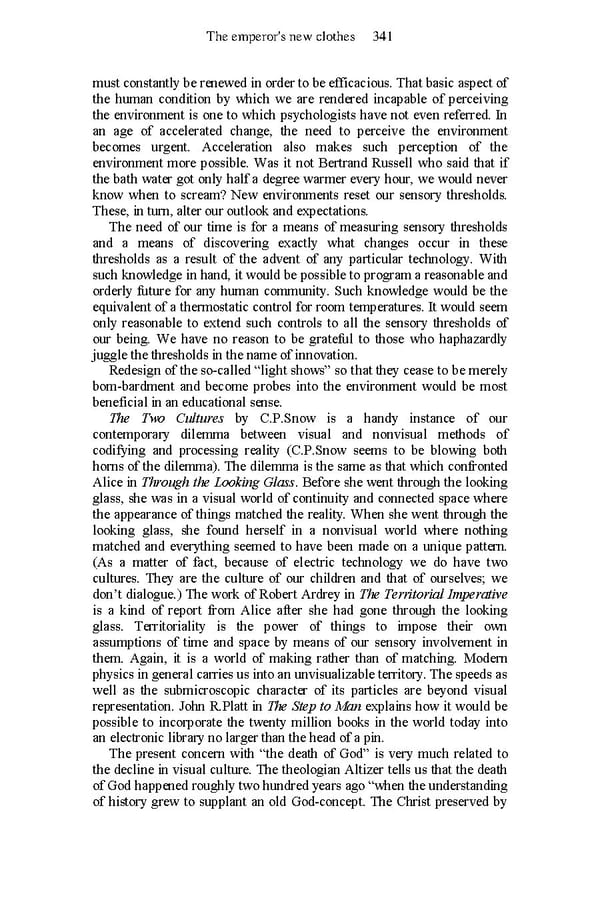The emperor's new clothes 341 must constantly be renewed in order to be efficacious. That basic aspect of the human condition by which we are rendered incapable of perceiving the environment is one to which psychologists have not even referred. In an age of accelerated change, the need to perceive the environment becomes urgent. Acceleration also makes such perception of the environment more possible. Was it not Bertrand Russell who said that if the bath water got only half a degree warmer every hour, we would never know when to scream? New environments reset our sensory thresholds. These, in turn, alter our outlook and expectations. The need of our time is for a means of measuring sensory thresholds and a means of discovering exactly what changes occur in these thresholds as a result of the advent of any particular technology. With such knowledge in hand, it would be possible to program a reasonable and orderly future for any human community. Such knowledge would be the equivalent of a thermostatic control for room temperatures. It would seem only reasonable to extend such controls to all the sensory thresholds of our being. We have no reason to be grateful to those who haphazardly juggle the thresholds in the name of innovation. Redesign of the so-called “light shows” so that they cease to be merely bom-bardment and become probes into the environment would be most beneficial in an educational sense. The Two Cultures by C.P.Snow is a handy instance of our contemporary dilemma between visual and nonvisual methods of codifying and processing reality (C.P.Snow seems to be blowing both horns of the dilemma). The dilemma is the same as that which confronted Alice in Through the Looking Glass. Before she went through the looking glass, she was in a visual world of continuity and connected space where the appearance of things matched the reality. When she went through the looking glass, she found herself in a nonvisual world where nothing matched and everything seemed to have been made on a unique pattern. (As a matter of fact, because of electric technology we do have two cultures. They are the culture of our children and that of ourselves; we don’t dialogue.) The work of Robert Ardrey in The Territorial Imperative is a kind of report from Alice after she had gone through the looking glass. Territoriality is the power of things to impose their own assumptions of time and space by means of our sensory involvement in them. Again, it is a world of making rather than of matching. Modern physics in general carries us into an unvisualizable territory. The speeds as well as the submicroscopic character of its particles are beyond visual representation. John R.Platt in The Step to Man explains how it would be possible to incorporate the twenty million books in the world today into an electronic library no larger than the head of a pin. The present concern with “the death of God” is very much related to the decline in visual culture. The theologian Altizer tells us that the death of God happened roughly two hundred years ago “when the understanding of history grew to supplant an old God-concept. The Christ preserved by
 Essential McLuhan Page 347 Page 349
Essential McLuhan Page 347 Page 349